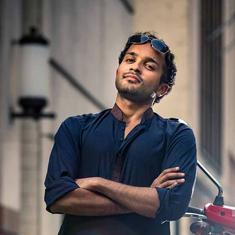Not given easily to creating new raags, Vilayat Khan did however compose a few. Of these, he performed Sanjh Saravali on several occasions. While this evening raag has a combination of phrases from the expansive raags Yaman Kalyan and Bihag and the more austere Hem, it does not represent the classic jod or compound raag format. Vilayat Khan seamlessly weaves in and out of the constituent raags, giving an impression of this being a raag that is flexible in its grammatical structure and yet able to create its individual mood.
Ustad Vilayat Khan and Pandit Kumar Bose
Here is Vilayat Khan in a live concert accompanied by tabla player Kumar Bose, the well-known Banaras gharana exponent. The performance begins with an aalaap or introductory free-flowing unaccompanied melody. Vilayat Khan draws out the essence of each swara and phrase through meends or long glides and other ornamentations or through carefully juxtaposed unadorned swaras.
The jod begins at 42.22”, with the establishing of a regular pulse, and accelerates gradually to the short jhala section that has repetitive and intricate right hand strokes. Vilayat Khan then launches into a taan section that has a series of various permutations and combinations of phrases played at great speed. He uses gamak or rapid oscillations on every swara, changes the tonal quality by plucking the string differently with the mizraab or plectrum, and exhibits amazing finger-work on the fret board.
The vilambit or slow composition that follows is set to Teentaal, a cycle of 16 matras. Kumar Bose makes a dramatic and extended entry, first playing only right hand strokes and then adding the base drum. The second composition is set to a fast-paced Teentaal. The performance ends with a jhala with a display of virtuosity from both performers.
Pandit Ulhas Kashalkar
Noted vocalist Ulhas Kashalkar, who has trained in the Gwalior, Agra and Jaipur-Atrauli styles, sings raag Sanjh Saravali. Having learnt the raag from Vilayat Khan, he sings two of the sitar maestro’s vocal compositions, both set to Teentaal. The song-text of the drut or fast composition has poetry, pakhawaj syllables, and sargam or solfège.










